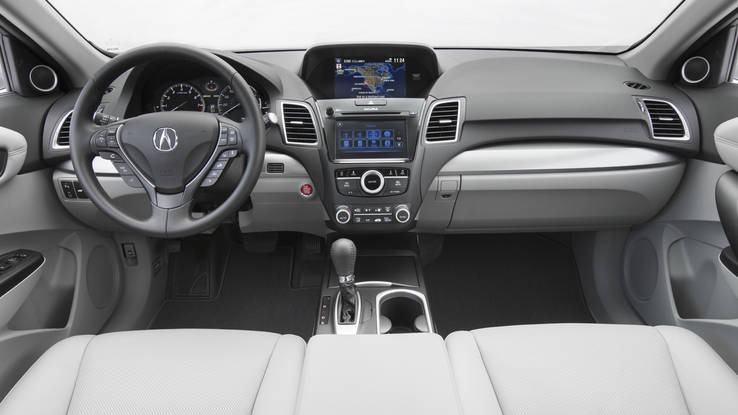Not the most exciting crossover, but strong on utility and value
What is it?
The 2016 Acura RDX received a full-face makeover for the new model year, and frankly, it needed it. Though the last one didn’t get the brand’s unfortunate full-beak nose treatment, it suffered from plain-Jane looks even in a segment not known for exciting styling.
Acura updated the appearance and added its cool Jewel Eye headlights along with LED taillights with light piping, all of which does a good bit to spruce up the front and rear fascias. The bumper gets a few extra character lines, and the fog lights have mesh inserts and a protruding border. The back is the same — more character lines, everything looks a little sharper and the rear reflectors are a little deeper, with cooler-looking surrounds.
Overall, the visual still won’t blow you away, but Acura found a good balance between too much beak and not enough flair.
Power still comes from Honda’s 3.5-liter SOHC VTEC V6. It now makes 279 hp and 252 lb-ft, up a few ticks from last year. The EPA says it gets 19 mpg in the city and 28 on the highway. A six-speed automatic handles gear changes and sends power to all four corners.

Lighter colors help add some character to the Acura RDX’s otherwise-uninspired interior design.
What’s it like to drive?
Drivers of the RDX are greeted with a plain but clean-looking dash and instrument panel with some metal accents. Dual screens dominate the central portion, which allows for the use of navigation and sound or climate controls at the same time. The wheel is littered with buttons, some of which get pressed when gripping the wheel in a turn, but overall having everything within reach is a net positive.
The seats are comfortable and easy to adjust, though a little flat on the back and bottom — the RDX isn’t a corner carver, so comfort is on the menu. There’s a good amount of room by your feet and a nice, big dead pedal on which to rest your left foot.

The RDX is downright quick thanks to its 279-hp V6, with good throttle response as soon as you touch the pedal. Like all VTEC engines, it pulls harder in the higher rev ranges, mostly above 4,000 rpm. Shifts from the automatic are plenty smooth, and the paddles are basically jewelry, telling the car’s brain that “it’s OK to shift now, if you’d like.” The 3.5 doesn’t really have a growl to speak of, but at a full-tilt shift, it has a little musicality to it. The brakes bite quickly when you press the pedal, which may take a little getting used to, but it’s far better than the alternative of too much travel.
Steering is easy at slow speeds and when entering or maneuvering around parking lots — which is its home environment — but it quickens up and adds weight at speed. As far as SUVs go, this one is more sprightly than most. Initial turn-in is good, and long, sweeping cloverleaf expressway entrances don’t require many mid-corner corrections.
Bumps are handled by a MacPherson strut setup in front and a multilink design in back. Front and rear stabilizer bars keep everything planted. Most potholes arrive with a muffled thud in the cabin and can throw the car off its course a bit, but they have to be big, and the RDX has to be going slow. Bumps at speed on the highway are mostly absorbed.
Visibility is good out of the front and back, though with the rearview/cross-traffic indicating screen, we didn’t have to crane our necks too much. The blind-spot indicators cover to the left and right, but it’s just as easy to whip your head around for a split second.

With the rear seats up, 26 cu ft of cargo space is available; fold them down and you get more than 70 cu ft
Do I want it?
We know the RDX brings the sport, at least relatively, but people buy crossovers for utility more than anything else. And besides a third row, this vehicle has utility in spades.
When the rear seats are in position, drivers have about 26 cubic feet of cargo space; that’s nearly tripled when the second row is down. It could surely fit a big grocery run or enough food for a week of camping. The interior can comfortably accommodate four adults for a long drive without complaint — five for a shorter stint. Three kids in the back — though in close quarters — would survive. Your nerves could go either way.
The RDX can tow a little, about 1,500 pounds to be exact. That’s enough for a Jet Ski, small boat or maybe an ATV or two. The hitch is about $ 500 from the factory.
Out on the dealership lot, the RDX has some decent competition from Audi’s Q5 ($ 39,300) and the Volvo XC60 ($ 36,400). Our RDX is $ 44,340 with options, but its front-wheel-drive base price is more like $ 35K. The Infiniti QX50, formerly the EX, is a bit bigger all the way around but has a few more ponies, too. Like the rest, its base price is around $ 35,000. If you err on the side of sport in your crossovers, we’d recommend the RDX or the Q5. If it’s luxury and safety you’re after, the Infiniti and Volvo are probably more for you.
The Acura RDX, though, outsold nearly all competitors in the first six months of 2015, and sales are up 15 percent since last year. Acura has a good one-two punch with the MDX and RDX. Now, if the company could inject a little enthusiasm into its sedan lineup, or maybe even introduce a coupe, we’d really be getting somewhere.




























